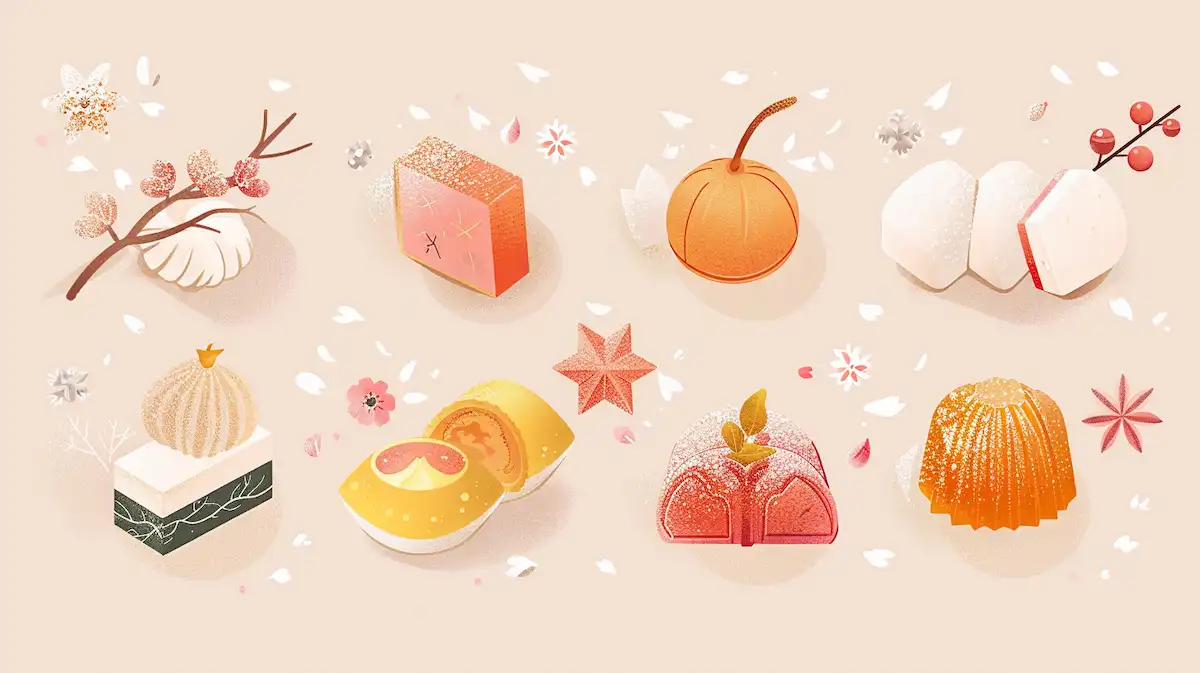ずんだ餅を英語で説明・紹介するための基本情報と、英会話に役立つ表現をシンプルでわかりやすい英語で紹介します。
英会話ダイアローグ・関連情報・10の質問を通して、ずんだ餅に関する英語表現を学びます。
英語
英会話ダイアローグを読む前に知っておくと良い前提知識と情報です。
- ずんだ餅とは
- もち米から作った餅に、枝豆(若い緑豆)をすり潰して作ったペーストを塗った宮城の伝統的なお菓子
- 朝市
- 仙台や他の多くの日本の都市では、地元の農産物や海産物、加工食品を販売する朝市が開かれる
- これらの市場は、新鮮な食材を求める地元住民や観光客に人気がある
- お土産文化
- 日本では、旅行先から地元の特産品を友人や家族にお土産として持ち帰る文化がある
- ずんだ餅は、宮城県や仙台市訪問の際の人気のお土産の一つ
2人がずんだ餅について話しています。
ずんだ餅の特徴、味わい、それを購入できる場所について話し、お土産としての人気にも触れています。
会話 / dialogue

Hey, Key! I just got back from Sendai and tried Zunda Mochi. It was incredible!

Oh, really? I’ve heard about Zunda Mochi but never tried it. What’s it like?

It’s a traditional sweet from Miyagi. They make it by covering mochi with a paste of crushed edamame. The blend of sweetness and the fresh flavor of green soybeans is just perfect.

Sounds delicious! I always thought mochi was only sweet because of the sugar, but this seems different.

Exactly, it’s not just sweet. The edamame gives it a unique taste, slightly nutty and very fresh. And the texture is amazing too – chewy mochi with creamy zunda on top.

Where did you find it in Sendai?

I stumbled upon it at a morning market. There were so many fresh local foods, but the Zunda Mochi caught my eye. The vendor even explained how it’s made and why it’s so special to Miyagi.

That sounds like a great experience. Did you bring any back?

I did! I bought some as souvenirs. It’s popular not just for its taste but as a way to share a piece of the local culture. It seems like a perfect gift.

I’d love to try some. And maybe we should plan a trip to Sendai together. I want to experience that morning market and try the freshest Zunda Mochi.

Absolutely, you’ll love it. The freshness of the food there is something else. And Zunda Mochi tastes even better when you’re enjoying it right where it’s from.

Let’s plan for it then. Thanks for sharing, Mack. I’m really looking forward to tasting Zunda Mochi and exploring Sendai with you.

Anytime, Key. It’ll be a trip to remember!
関連情報 / related information
「ずんだ餅」について、理解を深めるための「英語での関連情報」です。
ずんだ餅

Introduction to Zunda Mochi
Zunda Mochi is a traditional Japanese sweet famous in Miyagi Prefecture, part of the Tohoku region. This delicacy combines mochi, a sticky rice cake, with a unique paste made from crushed edamame (young soybeans). Its sweet and slightly salty flavor offers a taste of Japan’s rich culinary tradition.
Ingredients and Preparation
The main ingredients of Zunda Mochi are simple: mochi and edamame. First, edamame beans are boiled, peeled, and then crushed into a smooth paste. Sugar and a pinch of salt are added to the paste, which is then spread over or mixed with pieces of soft, chewy mochi. The result is a harmonious blend of sweet and savory, with a creamy texture.
Cultural Significance
Zunda Mochi is more than just a treat; it’s a part of the cultural heritage of Miyagi and the Tohoku region. Often enjoyed during festivals and special occasions, it represents the local flavors and traditions. For tourists, trying Zunda Mochi is a must-do for a genuine experience of regional Japanese cuisine.
Where to Find and Souvenir Culture
You can find Zunda Mochi in souvenir shops, traditional confectionery stores, and morning markets in Sendai and across Miyagi Prefecture. It’s a popular souvenir, reflecting the local culture and offering a unique taste of the area. Buying Zunda Mochi as a gift is a wonderful way to share the flavors of Miyagi with friends and family.
10の質問 / 10 questions
「ずんだ餅」について、理解を深めるための「英語での10の質問」です。
1: What is Zunda Mochi?
Zunda Mochi is a traditional Japanese sweet made from mochi (rice cake) and topped with a paste made from crushed edamame (young soybeans), sugar, and salt. It is particularly popular in the Tohoku region of Japan.
2: Where is Zunda Mochi from?
Zunda Mochi originates from the Tohoku region in Japan, especially in Miyagi Prefecture where it is considered a local delicacy.
3: What does Zunda Mochi taste like?
Zunda Mochi has a unique, sweet, and slightly salty flavor. The edamame paste gives it a fresh, nutty taste, which complements the soft and chewy texture of the mochi.
4: How is Zunda Mochi made?
To make Zunda Mochi, edamame beans are boiled, crushed into a paste, and then mixed with sugar and a pinch of salt. This paste is then spread over or mixed into cooked mochi.
5: What makes Zunda Mochi special?
What makes Zunda Mochi special is its combination of textures and flavors—the soft chewiness of mochi with the creamy, sweet, and nutty paste of edamame. It’s also rich in nutrients due to the edamame.
6: When is Zunda Mochi typically eaten?
Zunda Mochi can be enjoyed year-round but is often associated with special occasions and festivals in the Tohoku region.
7: Is Zunda Mochi considered healthy?
Yes, Zunda Mochi is considered relatively healthy because edamame is high in protein, vitamins, and minerals, which are beneficial for health.
8: Can Zunda Mochi be found outside of Tohoku?
While Zunda Mochi is a specialty of the Tohoku region, it has become available in other parts of Japan, especially at Japanese sweets shops that specialize in traditional desserts.
9: How should Zunda Mochi be served?
Zunda Mochi is best served at room temperature or slightly warmed. It can be enjoyed as it is, or sometimes it’s paired with tea as a complement.
10: What is the cultural significance of Zunda Mochi?
Zunda Mochi holds cultural significance in the Tohoku region as a traditional food that is often shared during gatherings and festivals. It represents a connection to the agricultural practices and culinary traditions of the area.
和訳付
会話 / dialogue

Hey, Key! I just got back from Sendai and tried Zunda Mochi. It was incredible!
ねえ、キー!仙台から戻ったところなんだ。ずんだ餅を試してきたよ。本当にすごかった!

Oh, really? I’ve heard about Zunda Mochi but never tried it. What’s it like?
ほんとに?ずんだ餅については聞いたことあるけど、食べたことないな。どんな感じ?

It’s a traditional sweet from Miyagi. They make it by covering mochi with a paste of crushed edamame. The blend of sweetness and the fresh flavor of green soybeans is just perfect.
宮城の伝統的なお菓子だよ。もちを枝豆のペーストで覆って作るんだ。甘さと枝豆の新鮮な風味の組み合わせが完璧なんだ。

Sounds delicious! I always thought mochi was only sweet because of the sugar, but this seems different.
おいしそう!もちって砂糖の甘さだけだと思ってたけど、これは違うみたいだね。

Exactly, it’s not just sweet. The edamame gives it a unique taste, slightly nutty and very fresh. And the texture is amazing too – chewy mochi with creamy zunda on top.
その通り、ただ甘いだけじゃないんだ。枝豆が独特の味を出していて、少しナッティーでとても新鮮なんだ。食感も素晴らしいんだよ – もちもちのもちにクリーミーなずんだが乗っている。

Where did you find it in Sendai?
仙台でどこで見つけたの?

I stumbled upon it at a morning market. There were so many fresh local foods, but the Zunda Mochi caught my eye. The vendor even explained how it’s made and why it’s so special to Miyagi.
朝市で偶然見つけたんだ。新鮮な地元の食べ物がたくさんあったけど、ずんだ餅が目を引いたんだ。売り手がどうやって作られているか、そしてなぜそれが宮城にとって特別なのかを説明してくれたよ。

That sounds like a great experience. Did you bring any back?
それは素晴らしい体験だね。お土産に持ち帰ったの?

I did! I bought some as souvenirs. It’s popular not just for its taste but as a way to share a piece of the local culture. It seems like a perfect gift.
うん、持ち帰ったよ!お土産としていくつか買ったんだ。味だけでなく、地元の文化の一部を共有する方法としても人気があるんだ。完璧な贈り物のように思えるよ。

I’d love to try some. And maybe we should plan a trip to Sendai together. I want to experience that morning market and try the freshest Zunda Mochi.
いくつか試してみたいな。そして、一緒に仙台への旅行を計画しようかな。その朝市を体験して、一番新鮮なずんだ餅を試してみたいんだ。

Absolutely, you’ll love it. The freshness of the food there is something else. And Zunda Mochi tastes even better when you’re enjoying it right where it’s from.
もちろん、君はそれを気に入るよ。そこの食べ物の新鮮さは格別だから。ずんだ餅は、その発祥の地で味わうとさらに美味しいんだ。

Let’s plan for it then. Thanks for sharing, Mack. I’m really looking forward to tasting Zunda Mochi and exploring Sendai with you.
じゃあ計画を立てよう。話してくれてありがとう、マック。ずんだ餅を試して、君と一緒に仙台を探検するのが本当に楽しみだよ。

Anytime, Key. It’ll be a trip to remember!
いつでもいいよ、キー。忘れられない旅になるだろうね!
関連情報 / related information
ずんだ餅

Introduction to Zunda Mochi
Zunda Mochi is a traditional Japanese sweet famous in Miyagi Prefecture, part of the Tohoku region. This delicacy combines mochi, a sticky rice cake, with a unique paste made from crushed edamame (young soybeans). Its sweet and slightly salty flavor offers a taste of Japan’s rich culinary tradition.
ずんだ餅について
ずんだ餅は、東北地方の宮城県で有名な日本の伝統的なお菓子です。このデリカシーは、もち(粘り気のある米ケーキ)と、枝豆(若い大豆)を潰して作ったユニークなペーストを組み合わせたものです。甘くて少し塩っぽい味が、日本の豊かな料理伝統の味を提供します。
Ingredients and Preparation
The main ingredients of Zunda Mochi are simple: mochi and edamame. First, edamame beans are boiled, peeled, and then crushed into a smooth paste. Sugar and a pinch of salt are added to the paste, which is then spread over or mixed with pieces of soft, chewy mochi. The result is a harmonious blend of sweet and savory, with a creamy texture.
材料と調理法
ずんだ餅の主な材料はシンプルです:もちと枝豆です。まず、枝豆を茹でて皮を剥き、滑らかなペーストに潰します。砂糖と少量の塩を加えたペーストを、柔らかくてもちもちのもちの上に塗ったり混ぜたりします。その結果、甘くておいしい、クリーミーな食感の調和のとれたブレンドができあがります。
Cultural Significance
Zunda Mochi is more than just a treat; it’s a part of the cultural heritage of Miyagi and the Tohoku region. Often enjoyed during festivals and special occasions, it represents the local flavors and traditions. For tourists, trying Zunda Mochi is a must-do for a genuine experience of regional Japanese cuisine.
文化的な意義
ずんだ餅はただのおやつ以上のものです。それは宮城県と東北地方の文化遺産の一部です。祭りや特別な機会に楽しまれることが多く、地元の風味と伝統を象徴しています。観光客にとって、ずんだ餅を試すことは、地域の日本料理を本物の体験するための必須事項です。
Where to Find and Souvenir Culture
You can find Zunda Mochi in souvenir shops, traditional confectionery stores, and morning markets in Sendai and across Miyagi Prefecture. It’s a popular souvenir, reflecting the local culture and offering a unique taste of the area. Buying Zunda Mochi as a gift is a wonderful way to share the flavors of Miyagi with friends and family.
どこで見つけることができるか、お土産文化
ずんだ餅は、仙台や宮城県全域のお土産店、伝統的な和菓子店、朝市で見つけることができます。地元の文化を反映し、その地域のユニークな味を提供する人気のお土産です。ずんだ餅を贈り物として買うことは、宮城の味を友人や家族と共有する素晴らしい方法です。
10の質問 / 10 questions
1: What is Zunda Mochi?
ずんだ餅とは何ですか?
Zunda Mochi is a traditional Japanese sweet made from mochi (rice cake) and topped with a paste made from crushed edamame (young soybeans), sugar, and salt. It is particularly popular in the Tohoku region of Japan.
ずんだ餅は、もち(米のケーキ)から作られ、若い大豆(枝豆)、砂糖、塩から作られたペーストをトッピングした日本の伝統的なお菓子です。特に日本の東北地方で人気があります。
2: Where is Zunda Mochi from?
ずんだ餅はどこで作られていますか?
Zunda Mochi originates from the Tohoku region in Japan, especially in Miyagi Prefecture where it is considered a local delicacy.
ずんだ餅は日本の東北地方、特に地元の珍味とされる宮城県が発祥の地です。
3: What does Zunda Mochi taste like?
ずんだ餅の味はどうですか?
Zunda Mochi has a unique, sweet, and slightly salty flavor. The edamame paste gives it a fresh, nutty taste, which complements the soft and chewy texture of the mochi.
ずんだ餅はユニークで甘く、少し塩辛い味がします。枝豆のペーストが新鮮でナッツのような味を与え、もちの柔らかくもちもちとした食感を引き立てます。
4: How is Zunda Mochi made?
ずんだ餅はどのようにして作られますか?
To make Zunda Mochi, edamame beans are boiled, crushed into a paste, and then mixed with sugar and a pinch of salt. This paste is then spread over or mixed into cooked mochi.
ずんだ餅を作るために、枝豆を茹でてペースト状に潰し、砂糖と少量の塩を混ぜます。このペーストを調理済みのもちに塗ったり混ぜたりします。
5: What makes Zunda Mochi special?
ずんだ餅の特別な点は何ですか?
What makes Zunda Mochi special is its combination of textures and flavors—the soft chewiness of mochi with the creamy, sweet, and nutty paste of edamame. It’s also rich in nutrients due to the edamame.
ずんだ餅の特別な点は、もちの柔らかなもちもち感と枝豆のクリーミーで甘くナッツのようなペーストの食感と味の組み合わせです。また、枝豆により栄養価が高いです。
6: When is Zunda Mochi typically eaten?
ずんだ餅は通常いつ食べられますか?
Zunda Mochi can be enjoyed year-round but is often associated with special occasions and festivals in the Tohoku region.
ずんだ餅は一年中楽しむことができますが、東北地方の特別な行事や祭りと関連付けられることが多いです。
7: Is Zunda Mochi considered healthy?
ずんだ餅は健康的と考えられていますか?
Yes, Zunda Mochi is considered relatively healthy because edamame is high in protein, vitamins, and minerals, which are beneficial for health.
はい、ずんだ餅は枝豆がたんぱく質やビタミン、ミネラルを豊富に含むため、比較的健康的と考えられています。
8: Can Zunda Mochi be found outside of Tohoku?
ずんだ餅は東北地方以外で見つかりますか?
While Zunda Mochi is a specialty of the Tohoku region, it has become available in other parts of Japan, especially at Japanese sweets shops that specialize in traditional desserts.
ずんだ餅は東北地方の特産品ですが、日本の他の地域、特に伝統的なデザートを専門とする日本のお菓子屋さんで入手可能になっています。
9: How should Zunda Mochi be served?
ずんだ餅はどのようにして提供されるべきですか?
Zunda Mochi is best served at room temperature or slightly warmed. It can be enjoyed as it is, or sometimes it’s paired with tea as a complement.
ずんだ餅は室温か少し温めた状態で提供するのが最適です。そのまま楽しむことも、お茶と一緒に楽しむこともあります。
10: What is the cultural significance of Zunda Mochi?
ずんだ餅の文化的な意義は何ですか?
Zunda Mochi holds cultural significance in the Tohoku region as a traditional food that is often shared during gatherings and festivals. It represents a connection to the agricultural practices and culinary traditions of the area.
ずんだ餅は、集まりや祭りの際によく共有される伝統的な食べ物として、東北地方で文化的な意義を持っています。それはその地域の農業慣習と料理の伝統につながっています。
words & phrases
英会話ダイアローグと関連情報に出てきた単語・フレーズです(例文は各3つ)。

nutty : 形容詞
意味: ナッツのような味や香りがする。Having the flavor or scent of nuts.
(ずんだ餅の枝豆のペーストが、少しナッティーで新鮮な味わいを加えることを指す)
例文
The almond cookies have a lovely nutty flavor.
「アーモンドクッキーには、素敵なナッツの風味があります。」
I enjoy the nutty aroma of roasted sesame seeds.
「私は焼きごまのナッツのような香りが好きです。」
This cheese has a slightly nutty taste.
「このチーズは少しナッツのような味がします。」
chewy : 形容詞
意味: 噛みごたえのある。Needing to be chewed for a long time before swallowing.
(ずんだ餅のもちもちとした食感を表現する際に使われる)
例文
I love the chewy texture of this bread.
「このパンのもちもちした食感が好きです。」
These gummy candies are really chewy.
「これらのグミキャンディは本当に噛みごたえがあります。」
The steak was tough and chewy.
「そのステーキは固くて噛みごたえがありました。」
stumble upon : 動詞句
意味: 偶然見つける。To find or discover something by chance.
(仙台の朝市でずんだ餅を偶然見つけたことを指す)
例文
While hiking, we stumbled upon a hidden waterfall.
「ハイキング中に、隠れた滝を偶然見つけました。」
He stumbled upon a rare book at the flea market.
「彼はフリーマーケットで珍しい本を偶然見つけました。」
I stumbled upon an old friend in the city center.
「市の中心で昔の友人に偶然出会いました。」
delicacy : 名詞
意味: 珍味、美食。A rare or expensive food item that is considered highly desirable.
(ずんだ餅が宮城県の伝統的な珍味として扱われることを指す)
例文
Sushi is considered a delicacy in many countries.
「寿司は多くの国で珍味と考えられています。」
The restaurant specializes in local delicacies.
「そのレストランは地元の珍味に特化しています。」
Trying regional delicacies is part of the travel experience.
「地域の珍味を試すことは、旅行の経験の一部です。」
a pinch of : 句
意味: ほんの少しの。A very small amount of something, especially of spice or seasoning added to food.
(ずんだ餅の枝豆のペーストに、味を整えるためにほんの少しの塩を加えることを指す)
例文
Just add a pinch of salt to enhance the flavor.
「風味を高めるために、ほんの少しの塩を加えてください。」
A pinch of cinnamon can make a big difference in a recipe.
「ほんの少しのシナモンを加えるだけで、レシピに大きな違いが出ます。」
I always use a pinch of sugar in my tomato sauce.
「トマトソースにはいつも少しの砂糖を使います。」
詳細情報 / Further Info
関連記事(和菓子)

